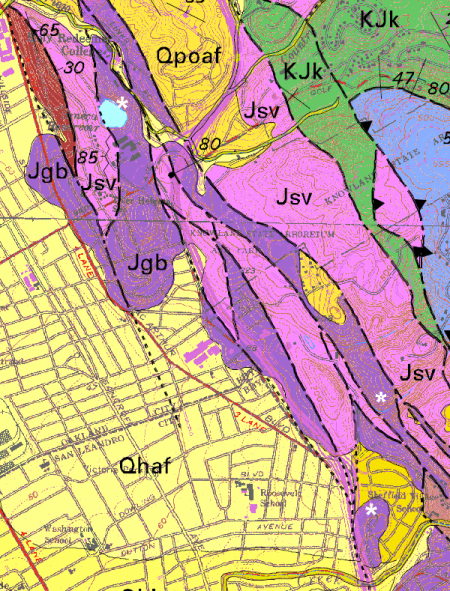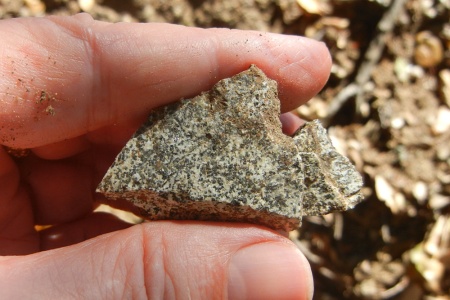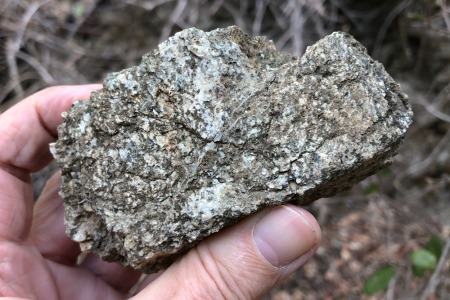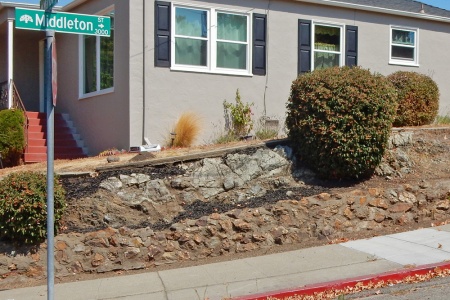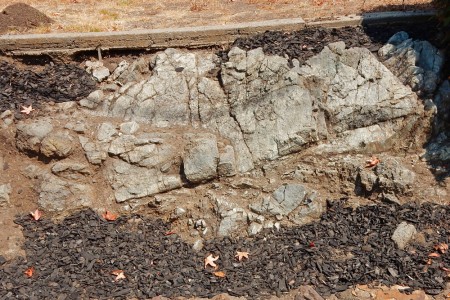A commenter asked, in connection with a recent post, if I’d written anything about Oakland’s ophiolite. The answer is, not specifically until now. The Coast Range ophiolite (OH-feel-ite) is a string of mostly disconnected outcrops of unusual rocks that extends north almost to Redding and south almost to Point Conception, rather like the way my writing about it runs through the ragged string of posts on this blog between late 2007 and today. In Oakland, the serpentinite patch is part of it, the San Leandro gabbro is part of it, and the Leona volcanics are part of it (see posts about that part here and here).
Here’s a recent simplified geologic map from a 2005 paper by ophiolite savant John Shervais (doi: 10.1130/B25443.1, available here) showing the most important bits of the ophiolite in black. It’s kind of a privilege to have a piece of it in our city.
The details in California are intricate and I’m about ankle-deep into them at the moment, so I’ll be pretty general here. Ophiolites were first recognized as a suite of related rock types over 200 years ago, at the dawn of scientific geology, in the Alps. Alexandre Brongniart gave them the name, which means “snake rock” in scientific Greek, because serpentinite (“snake rock” in scientific Latin) is so typical of them. About 50 years ago, at the dawn of plate tectonics, they were recognized as pieces of oceanic crust that somehow have ended up on land during the elephantine dance of the tectonic plates.
The oceanic crust of most ophiolites is not as well organized as the standard oceanic crust formed at mid-ocean ridges. It forms in the roiling setting near subduction zones, where subducting plates sink straight down and draw the other side toward them. (This situation, called slab rollback, is the opposite of what we’re taught in popular accounts that talk about subduction in terms of colliding continents and mountain-building.) As the plate on the other side is stretched thin, new magma forms beneath it, rises and freezes into fresh oceanic-style crust (the ophiolite). It’s because most ophiolites form near land next to subduction zones (the “suprasubduction-zone setting” in academic lingo), not way out to sea at mid-ocean ridges, that we find scraps of them plastered onto the continents in a couple hundred places around the world. There are some other tectonic schemes that make ophiolites, but this is the typical one.
Ophiolites consist of rocks that correspond to the major layers of oceanic plates, which are a deep base of peridotite, a middle layer of gabbro, an upper layer of basalt and a cap of mixed seafloor stuff: red clay, seamounts, volcanic chains and the odd limestone basin here and there. And most of these can be found in Oakland. The peridotite, when seawater reacts with it, turns quickly into serpentinite (but you can see rare remnants in places).
The gabbro, a coarse-grained rock of the same composition as basalt lava that has cooled slowly enough for visible mineral crystals to grow, underlies much of San Leandro and the deep-East Oakland hills.
And the Leona volcanics is a big pile of volcanic ash, shot through with dikes of basalt and now strongly altered, that sat on top.
The Coast Range ophiolite is highly disrupted now. It’s been caught up in millions of years of squeezing, stretching and kneading North America’s western edge — and that was before the San Andreas fault system arose and smeared everything sideways.
A handful of intrepid specialists continue the work that Brongniart started, reassembling and correlating and extrapolating and collecting ever more data. Ophiolites are important in the bigger scheme because some of them are the only pieces of seafloor rock that are older than the present ocean floor (which barely covers the Cretaceous period, back to about 140 million years). But if ophiolites are born poorly organized, unlike proper deep seafloor, attempting a perfect restoration may be an delusion, a will-o’-the-wisp. Our insights may always be a string of fragments, and we may have to let mystery be, but we have to try.
I also wrote this introductory piece about ophiolites for another website, once upon a time.

















